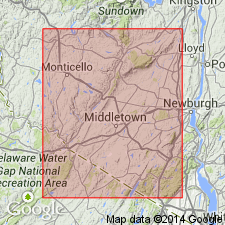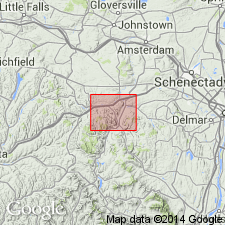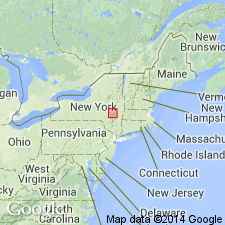
- Usage in publication:
-
- Binnewater quartzites
- Modifications:
-
- Named
- Dominant lithology:
-
- Quartzite
- AAPG geologic province:
-
- Appalachian basin
Summary:
Named Binnewater quartzites for Binnewater, Ulster Co., NY. Consists of quartzites that become more calcareous and shaly south of High Falls. Overlies the High Falls shale and underlies the Wilbur limestone. Unit is of Late Silurian age.
Source: GNU records (USGS DDS-6; Reston GNULEX).

- Usage in publication:
-
- Binnewater sandstone
- Modifications:
-
- Revised
- AAPG geologic province:
-
- Appalachian basin
Summary:
Revised the Binnewater to the Binnewater sandstone.
Source: GNU records (USGS DDS-6; Reston GNULEX).

- Usage in publication:
-
- Binnewater Sandstone*
- Modifications:
-
- Overview
- AAPG geologic province:
-
- Appalachian basin
Summary:
The Binnewater Sandstone in southeastern New York consists of interbedded, thin- to medium-bedded, cross-bedded, rippled, light-gray, quartzose sandstone, and partly mudcracked, green and gray silty shale, dolomite, and limestone. Lower contact is gradational with the High Falls Shale and the upper contact is gradational with the Rondout Formation. Some earlier reports have mistaken the Poxono Island Formation as the Binnewater Sandstone. Unit is of Late Silurian age.
Source: GNU records (USGS DDS-6; Reston GNULEX).
For more information, please contact Nancy Stamm, Geologic Names Committee Secretary.
Asterisk (*) indicates published by U.S. Geological Survey authors.
"No current usage" (†) implies that a name has been abandoned or has fallen into disuse. Former usage and, if known, replacement name given in parentheses ( ).
Slash (/) indicates name conflicts with nomenclatural guidelines (CSN, 1933; ACSN, 1961, 1970; NACSN, 1983, 2005, 2021). May be explained within brackets ([ ]).

